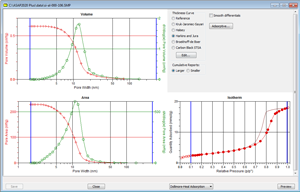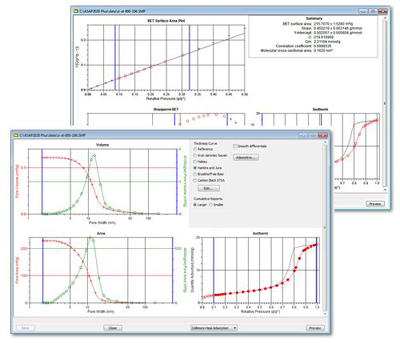Description
- Programmable, two-station degas system allows physisorption sample preparation while running a chemisorption analysis
- Twelve gas inlets allow multiple probe gases to be investigated maximizing efficiency and range of applications
- Dedicated exhaust port for external detector connections
- High-temperature 1100 °C furnace rapidly ramps to temperature and provides excellent, stable temperature and control with quick cool downs In situ chemisorption sample reparation and activation provide a fully automated method that does not require user intervention
- In situ chemisorption sample preparation and activation provide a fully automated method that does not require user intervention
- Design permits quick and easy transition from chemisorption to physisorption analysis
Typical ASAP 2020 Plus Applications
Pharmaceuticals:
- Surface area and porosity play major roles in the purification, processing, blending, tableting, and packaging of pharmaceutical products as well as their useful shelf life, dissolution rate, and bio-availability.
Ceramics:
- Surface area and porosity affect the curing and bonding of greenware and influence strength, texture, appearance, and density of finished goods. The surface area of glazes and glass frits affects shrinkage, crazing, and crawling.
Adsorbents:
- Knowledge of surface area, total pore volume, and pore size distribution is important for quality control of industrial adsorbents and in the development of separation processes. Surface area and porosity characteristics affect the selectivity of an adsorbent.
Activated Carbons:
- Surface area and porosity must be optimized within narrow ranges to accomplish gasoline vapor recovery in automobiles, solvent recovery in painting operations, or pollution controls in wastewater management.
Carbon Black:
- The wear lifetime, traction, and performance of tires are related to the surface area of carbon blacks used in their production.
Fuel Cells:
- Fuel cell electrodes require high surface area with controlled porosity to produce optimum power density.
Catalysts:
- The active surface area and pore structure of catalysts influence production rates. Limiting the pore size allows only molecules of desired sizes to enter and exit, creating a selective catalyst that will produce primarily the desired product.
Paints and Coatings:
- The surface area of a pigment or filler influences the gloss, texture, color, color saturation, brightness,solids content, and film adhesion properties. The porosity of a print media coating is important in offset printing where it affects blistering, ink receptivity, and ink holdout.
Projectile Propellant:
- The burn rate of propellants is a function of surface area too high a rate can be dangerous; too low a rate can cause malfunction and inaccuracy.
Medical Implants:
- Controlling the porosity of artificial bone allows it to imitate real bone that the body will accept and allow tissue to be grown around it.
Electronics:
- By selecting high surface area material with carefully designed pore networks, manufacturers of super-capacitors can minimize the use of costly raw materials while providing more exposed surface area for storage of charge.
Cosmetics:
- Surface area is often used by cosmetic manufacturers as a predictor of particle size when agglomeration tendencies of the fine powders make analysis with a particle-sizing instrument difficult.
Aerospace:
- Surface area and porosity of heat shields and insulating materials affect weight and function.
Geoscience:
- Porosity is important in groundwater hydrology and petroleum exploration because it relates to the quantity of fluid that a structure can contain as well as how much effort will be required to extract it.
Nanotubes:
- Nanotube surface area and microporosity are used to predict the capacity of a material to store hydrogen.
More Applications:
- Adhesives
- Alloys
- Abrasives
- Carbonates
- Cements
- Clays
- Detergents
- Fibers
- Films
- Fertilizers
- Filters
- Glass
- Food Additives
- Graphite
- Minerals
- Paper
- Polishing Compounds
- Polymers
- Resins
- Soils and Sediments
MicroActive for ASAP2020 Plus
Interactive Data Reduction Software:
- Micromeritics’ innovative MicroActiv software allows you to interactively evaluate isotherm data. You can easily include or exclude data, fitting the desired range of experimentally acquired data points using interactive, movable calculation bars. The isotherm can be viewed real-time on either a linear or logarithmic scale, available to you under each calculation model.
MicroActive reports for ASAP 2020 Plus Physisorption:
- Isotherm
- BET Surface Area
- Langmuir Surface Area
- t-Plot
- Alpha-S Method
- BJH Adsorption and Desorption
- Dollimore-Heal Adsorption and Desorption
- Temkin and Freundlich
- Horvath-Kawazoe
- MP-Method
- DFT Pore Size and Surface Energy
- Dubinin-Radushkevich
- Dubinin-Astakhov
- User Defined Reports

Calculations can be easily generated and adjusted. The selection bars allow for a range of data points to be quickly and easily selected.

Calculations can be easily generated and adjusted. The selection bars allow for a range of data points to be quickly and easily selected.
MicroActive for ASAP 2020 Plus Chemisorption:
MicroActive provides you with direct access and manipulation of chemical adsorption isotherm data. Unified Analysis Conditions for physical and chemical analyses allows you to rapidly develop new methods with a common interface.
Reported Data Include:
- Active Metal Surface Area
- Average Crystallite Size
- Irreversible and Reversible Sorption
- Monolayer Capacity
- Active Metal Dispersion
Data Reduction Features:
- Interaction with adsorption data is direct. By simply moving the calculation bars, the user is immediately updated with new textual properties.
- One-click access to important parameters.
- Interactive data manipulation minimizes the use of dialog boxes and tunneling of dialogs to specify calculation parameters.
- Improved ability to overlay files (up to 25) including mercury intrusion data with a file add-and-subtract feature and data from competitive instruments.
- User-selectable data ranges through the graphic interface allow direct modeling for BET, t-Plot, Langmuir, DFT interpretation, and much more. The MicroActive suite provides an extensive selection of NLDFT models for calculating pore size distributions.
- Report Options editor allows the user to define reports with on-screen previews. Each report has the ability to possess one summary, tabular, and graphical information pane.
- Powerful Python programming language allows you to develop extensions to the standard report available within the ASAP 2020 Plus MicroActive application.
Partnership and Support Network:
- Expertise in application assistance is only a phone call away. Every Micromeritics instrument is backed by a dedicated, knowledgeable staff of experts.
- Responsive worldwide service and technical support provides the needed security and peace of mind for you, our customers, ensuring that your sample and product development pathways continue to progress.
- Referenced in an extensive number of peer-reviewed articles in prestigious journals, your ASAP 2020 will link you to a large and growing community of users.
Optional Cryostat:
- A single-stage cryogenic refrigerator that operates on the Gifford-McMahon refrigeration cycle. It uses helium gas from a helium compressor(s) to offer a wide range of analytical temperatures with milli Kelvin levels of stability.





